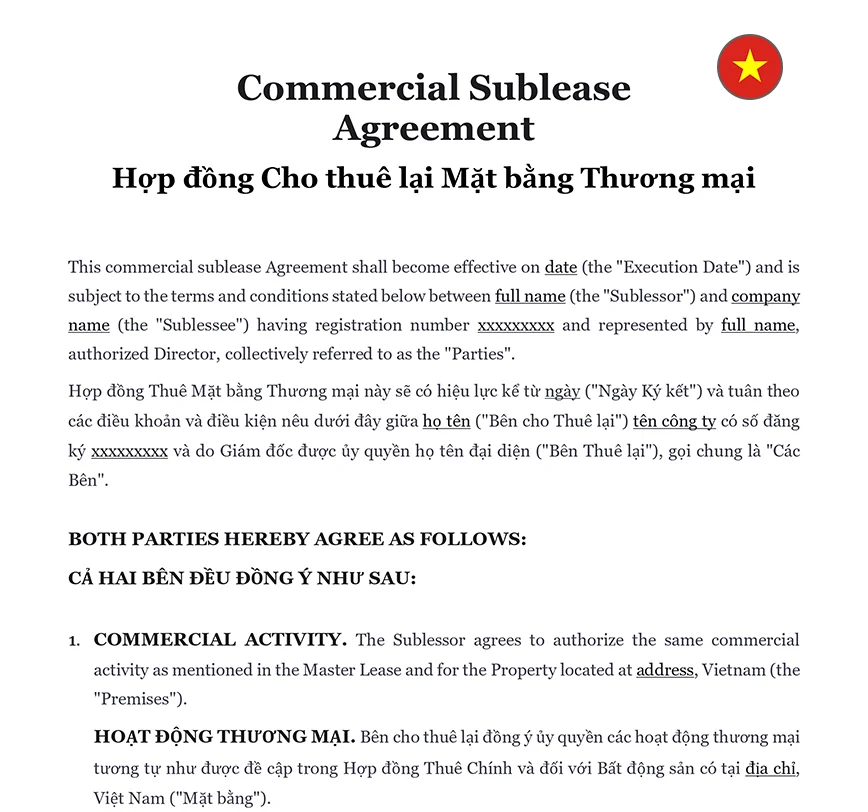Securing the landlord’s consent is a critical step in transferring rental rights. The original lease agreement often requires the landlord’s approval for any sublease or transfer of rental rights. It’s advisable to communicate with the landlord early in the process and obtain written consent. This ensures transparency and prevents legal complications. Providing the landlord with a copy of the proposed sublease agreement and any relevant details about the new tenant can facilitate this process. Landlord consent is essential for the sublease to be valid and enforceable.
1. Adherence to Vietnamese Laws: The transfer of rental rights must comply with the Civil Code 2015 and the Law on Real Estate Business 2014.
2. Execution of Legal Documents: Ensure all legal documents are correctly drafted and executed to meet legal standards.
3. Registration with Authorities: Register the transfer with relevant authorities, such as the Department of Natural Resources and Environment.
4. Protection of Interests: Compliance with these laws helps protect the interests of both the original tenant and the new tenant.
5. Legal Recognition: Proper adherence ensures that the transfer is legally recognized.
6. Avoidance of Disputes: Failure to comply with legal requirements can result in void agreements and potential legal disputes.
Ensure it allows for the transfer of rental rights. Check for any specific conditions or restrictions that may apply.
Secure written approval from the landlord. This is often a prerequisite for the validity of the sublease agreement.
Include all necessary details and comply with legal requirements by using our template. This document should be comprehensive and clear.
Both parties should sign the sublease agreement in the presence of a legal representative. Notarization may be required to ensure its legality. Register the agreement with the relevant local authorities. This step is crucial for the enforceability of the sublease.
Not Reviewing the Original Lease: Failing to check if the original lease permits subleasing can invalidate the transfer.
Skipping Landlord Consent: Proceeding without the landlord’s written approval can lead to legal disputes and potential eviction. Read How to Avoid Common Rental Contract Mistakes in Vietnam for common pitfalls.
Inadequate Documentation: Ensuring all necessary legal documents are properly drafted and executed is essential to prevent misunderstandings and enforce the agreement.
Engaging legal counsel is highly recommended when transferring rental rights for commercial properties. A lawyer can provide invaluable guidance on drafting agreements, obtaining necessary approvals, and ensuring compliance with all legal requirements. Legal experts can also assist in resolving any disputes that may arise during the transfer process. Utilizing professional legal services helps protect your interests and ensures that the transfer process is handled correctly.
After all agreements are signed and registered, it is important to finalize the transfer by conducting a handover process. This involves several key steps:
1. Inspect the Property: Both parties should thoroughly inspect the property to ensure it is in the agreed-upon condition.
2. Document the Condition: Create a detailed report of the property’s condition, noting any existing damages or issues.
3. Handover Keys and Access Codes: Provide the sublessee with all necessary keys and access codes for the property.
4. Agreement on Property Condition: Both the sublessor and sublessee should agree on the property’s condition at the time of transfer to avoid future disputes.
5. Confirm Completion: Ensure all necessary actions are completed and both parties are satisfied with the handover.











